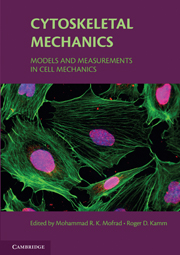Book contents
- Frontmatter
- Contents
- List of Contributors
- Preface
- 1 Introduction, with the biological basis for cell mechanics
- 2 Experimental measurements of intracellular mechanics
- 3 The cytoskeleton as a soft glassy material
- 4 Continuum elastic or viscoelastic models for the cell
- 5 Multiphasic models of cell mechanics
- 6 Models of cytoskeletal mechanics based on tensegrity
- 7 Cells, gels, and mechanics
- 8 Polymer-based models of cytoskeletal networks
- 9 Cell dynamics and the actin cytoskeleton
- 10 Active cellular protrusion: continuum theories and models
- 11 Summary
- Index
1 - Introduction, with the biological basis for cell mechanics
Published online by Cambridge University Press: 10 November 2009
- Frontmatter
- Contents
- List of Contributors
- Preface
- 1 Introduction, with the biological basis for cell mechanics
- 2 Experimental measurements of intracellular mechanics
- 3 The cytoskeleton as a soft glassy material
- 4 Continuum elastic or viscoelastic models for the cell
- 5 Multiphasic models of cell mechanics
- 6 Models of cytoskeletal mechanics based on tensegrity
- 7 Cells, gels, and mechanics
- 8 Polymer-based models of cytoskeletal networks
- 9 Cell dynamics and the actin cytoskeleton
- 10 Active cellular protrusion: continuum theories and models
- 11 Summary
- Index
Summary
Introduction
All living things, despite their profound diversity, share a common architectural building block: the cell. Cells are the basic functional units of life, yet are themselves comprised of numerous components with distinct mechanical characteristics. To perform their various functions, cells undergo or control a host of intra-and extracellular events, many of which involve mechanical phenomena or that may be guided by the forces experienced by the cell. The subject of cell mechanics encompasses a wide range of essential cellular processes, ranging from macroscopic events like the maintenance of cell shape, cell motility, adhesion, and deformation to microscopic events such as how cells sense mechanical signals and transduce them into a cascade of biochemical signals ultimately leading to a host of biological responses. One goal of the study of cell mechanics is to describe and evaluate mechanical properties of cells and cellular structures and the mechanical interactions between cells and their environment.
The field of cell mechanics recently has undergone rapid development with particular attention to the rheology of the cytoskeleton and the reconstituted gels of some of the major cytoskeletal components – actin filaments, intermediate filaments, microtubules, and their cross-linking proteins – that collectively are responsible for the main structural properties and motilities of the cell. Another area of intense investigation is the mechanical interaction of the cell with its surroundings and how this interaction causes changes in cell morphology and biological signaling that ultimately lead to functional adaptation or pathological conditions.
A wide range of computational models exists for cytoskeletal mechanics, ranging from finite element-based continuum models for cell deformation to actin filamentbased models for cell motility.
- Type
- Chapter
- Information
- Cytoskeletal MechanicsModels and Measurements in Cell Mechanics, pp. 1 - 17Publisher: Cambridge University PressPrint publication year: 2006
- 3
- Cited by



